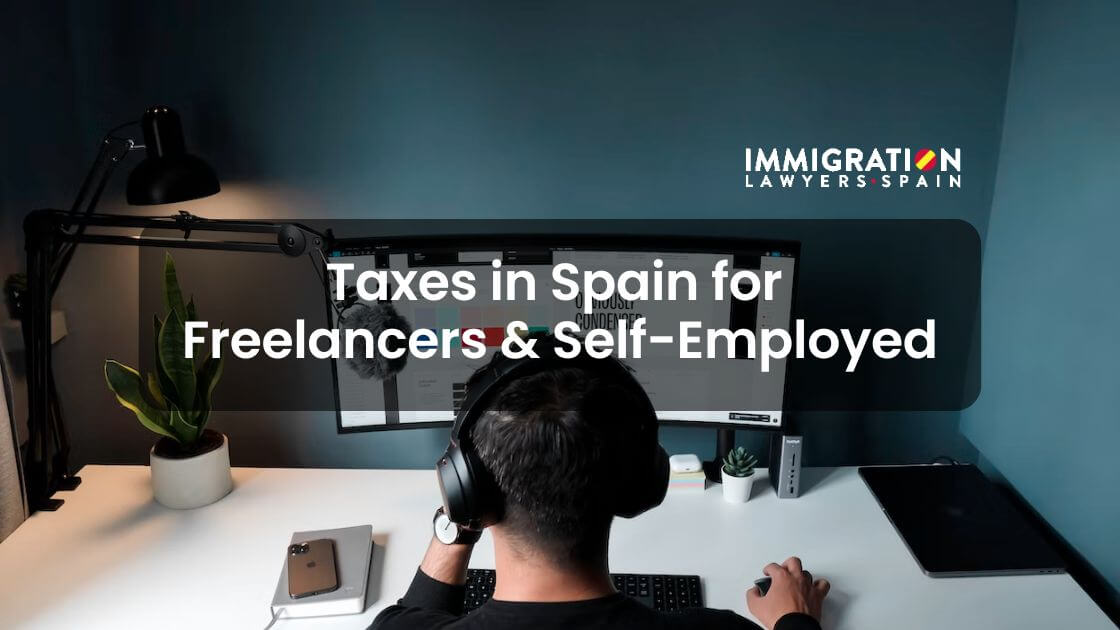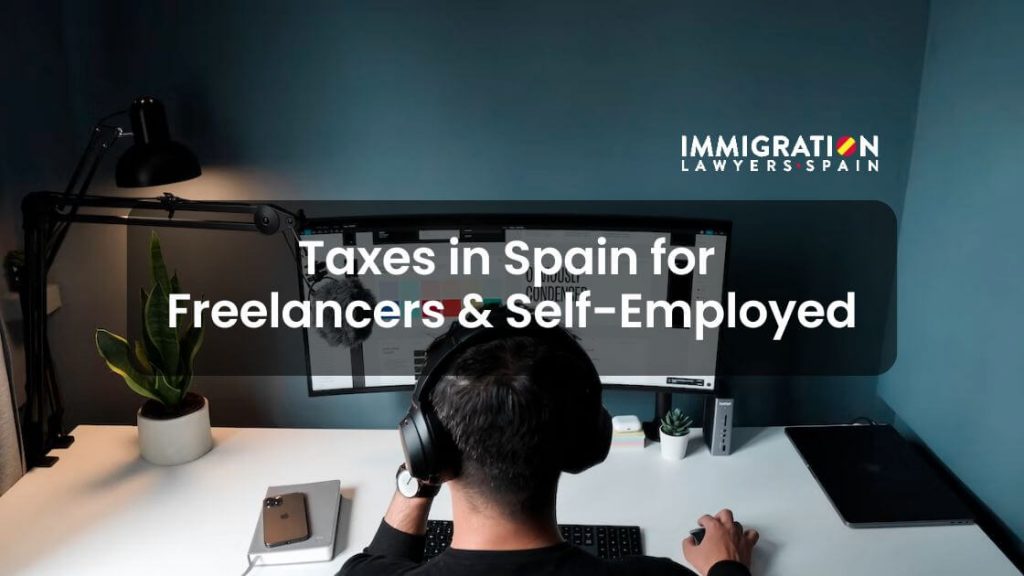
If you are considering becoming a freelancer in Spain, you must read this. As, without any doubt, the different taxes you will need to pay as a self-employed worker are for sure one of the main things to consider when making this decision.
In this article, we will explore the 3 main taxes any freelancer must pay in Spain on a monthly, quarterly, and annual basis; its different applicable rates, how to file them, and how to benefit from the available allowances that will help you save money.
Content
ToggleHow much is self-employed tax in Spain?
What many tend to refer to as self-employed tax is actually the general income tax any worker in Spain must pay (no matter if a freelancer or company employee).
This, as we will see in the upcoming section, constitutes one of the 3 main tax obligations all freelancers must face in the country.
We are talking about a progressive rate that varies depending on the income you generate during the whole tax year, which goes from January to December, and there are several allowances available.
*See exact rates in the next section, but spoiler: it ranges from 19 to 47%.
Besides that, there are 2 different and extra taxes you will need to pay: the monthly Social Security contribution, and your quarterly VAT.
The 3 taxes you will pay as an autonomo in Spain
Let’s explore the 3 big taxes that any freelancer must pay in the country after becoming an “autónomo”:
Income tax or IRPF (“Impuesto de la Renta de las Personas Físicas”)
Provided that you are a freelancer in Spain who spends more than 183 days per year in the country, you will become what is called a tax resident.
Tax residents must pay income tax in Spain on all incomes generated all around the world.
That, of course, includes the income they generate through their self-employed activities.
How much is that income tax exactly?
It depends.
It consists of a progressive rate that (generally) goes from 19 to 47%:
- From 0 to 12.450€: 19%
- From 12.450€ to 20.200€: 24%
- From 20.200€ to 35.200€: 30%
- From 35.200 to 60.000€: 37%
- From 60.000€ to 300.000€: 45%
- Above 300.000€: 47%
What also depends on your particular situation are the different allowances applicable to the base rate that will help you pay less. More on that in the next sections.
Due to this progressive rate, it is advisable to set up an SL if your income is above €60,000 (since the corporate tax to be paid is 25%).
Social Security Contributions as a Freelancer
Each month, the Spanish Social Security will charge you a fixed fee, and this is true even if you fail to make any money (that is if your income is 0€).
This fee is what will grant you access to the Spanish Health Care system, and also allow you to receive unemployment or sick leave benefits if required.
It is the same contribution companies do withdraw from your gross salary if you work for a company.
In Spain, this monthly Social Security fee is, at minimum, 293€.
We say minimum because you can choose to pay more than that in order to guarantee a higher pension once you retire.
Nevertheless, there are a few exceptions to this fixed fee:
- During your first 12 months as a freelancer, you will just pay 60€ per month
- During your second year (from month 13 to 24), you will pay 150€
- If you are a mother who returns from maternity, you can claim a 100% discount for 12 months
- And if you work full-time for a company but part-time as a freelance, you will automatically get a 50% reduction for the first 18 months, and then you will get a 25% reduction
VAT for self-employed workers (IVA)
Once each quarter (between the first 20 days of each quarter, on January, April, July and October), you file and pay your quarter VAT.
In Spain, VAT is 21%, and you will apply that extra rate to the different invoice services you send to your clients.
How it works is pretty simple.
During each quarter, each invoice you send will include an extra 21% on your prices. For each business-related invoice you received and for all those invoices for work-related products you have purchased (like a new phone or computer) you will pay that 21%.
At the end of the quarter, you must sum up all VATs you received, subtract VATs paid, and the difference is what you must pay to the Tax Agency.
You will do that using Model 303.
If you deal with business customers who are outside Spain (but within the EU) and are VAT registered, you may be exempt from paying this tax.
At the end of each year, you will also need to submit Model 390 including a summary of all VAT transactions throughout the year.
Do you have any doubts so far? Ask our business and tax lawyers anything, or keep reading for more information:
Freelance tax deductions in Spain
Up till here, we have analyzed the bad news: everything you must pay.
But now comes the good news: what you can deduct and all those concepts that will help you save money.
That is because, on your income tax declarations, you can deduct several invoices you have been paying throughout the year so that the final tax base can be lower.
What exactly can you deduct?
General deductions
The main things to deduct are:
- Your monthly social security contributions
- Any type of expense related to sustaining your freelance activity
- Tax and accounting invoices you paid
- Any tool or service that works as a subscription base that you use for your working operations
- Your health insurance monthly payment (up to 500€)
- Utilities like your phone and internet invoices
- Supplies, like your office
- Vehicles, in case those have been used for your freelance activity
Work from home deductions
But there is more. In case you work from home, the list goes on.
If that is the case, you can deduct up to 30% of all expenses you paid (internet, phone, gas, water, electricity) but just for the proportional part of your house dedicated to your professional activity (measured by square meters).
In order to do so, registering your address and linking it to your business address will be essential.
Besides, you can also claim up to 26,67€ per day for food expenses in case you eat lunch out; while this amount increases to 48,08€ in case you are outside the country.
Important note.
For all deductions to be applicable, you must prove the corresponding expenditures through formal invoices, in which your name, address, and tax identification number must appear.
Vehicle deductions
And, finally, in case using your car or motorbike is explicitly required for your freelancing activities, you may also deduct a 50% of related expenses.
Bear in mind that it will be necessary to demonstrate you have used the vehicle for business purposes.
How to file freelance tax
Once each year, you will do your yearly income tax declaration, which uses model 100 and contains all the incomes you received and taxes you paid during the previous year.
Nevertheless, there are two different options for the ongoing year.
If 70% or more of your clients make tax withholdings on the fees paid to you, it will work as follows.
On each invoice you send to your clients, you can choose to subtract from the total a standard 15% income tax, or a reduced 7%.
Then, once you do your annual income tax declaration, and according to how much you have generated during the year and after subtracting all the different allowances and bonification (as seen in the previous section), you will pay (or receive) the difference.
But there is also another option.
Using Model 130, you would quarterly pay, in advance, a 20% income tax for all the incomes you declare quarterly (without subtracting the 15 or 7% on each invoice).
But, if you use a modular system called “estimación objetiva”, you would use instead Model 131, and there your income levels will be based on estimations rather than on actual income.
Autonomo tax calculator
Finally, here you can find a small simulation you can use to understand how much taxes you will end up paying as a freelancer in Spain.
Bear in mind that exact numbers will completely change depending on your particular situation, but the following table can work as a good guide:
| Family Status | Annual Income (€) | With Flat Rate and 20% Reduction | Without Flat Rate or 20% Reduction | ||
|---|---|---|---|---|---|
| Self-Employed Fee (€) | Income Tax to Pay (€) | Self-Employed Fee (€) | Income Tax to Pay (€) | ||
| Single without children | 20,000 | 960 | 1,514.80 | 3,600 | 1,725.99 |
| Single without children | 40,000 | 960 | 5,450.40 | 3,600 | 6,551.46 |
| Single without children | 60,000 | 960 | 10,703.00 | 3,600 | 13,117.58 |
| Single without children | 80,000 | 960 | 16,648.25 | 3,600 | 20,811.70 |
| Single with 1 child | 20,000 | 960 | 1,294.62 | 3,600 | 1,505.81 |
| Single with 1 child | 40,000 | 960 | 5,230.22 | 3,600 | 6,331.28 |
| Single with 1 child | 60,000 | 960 | 10,482.82 | 3,600 | 12,897.40 |
| Single with 1 child | 80,000 | 960 | 16,428.07 | 3,600 | 20,591.52 |
| Single with 2 children | 20,000 | 960 | 1,046.91 | 3,600 | 1,258.10 |
| Single with 2 children | 40,000 | 960 | 4,982.51 | 3,600 | 6,083.57 |
| Single with 2 children | 60,000 | 960 | 10,235.11 | 3,600 | 12,649.69 |
| Single with 2 children | 80,000 | 960 | 16,180.36 | 3,600 | 20,343.81 |
| Married without children | 20,000 | 960 | 851.21 | 3,600 | 1,018.69 |
| Married without children | 40,000 | 960 | 4,505.20 | 3,600 | 5,606.26 |
| Married without children | 60,000 | 960 | 9,482.40 | 3,600 | 11,896.98 |
| Married without children | 80,000 | 960 | 15,285.77 | 3,600 | 19,349.70 |
| Married with 1 child | 20,000 | 960 | 410.84 | 3,600 | 578.32 |
| Married with 1 child | 40,000 | 960 | 4,064.83 | 3,600 | 5,165.89 |
| Married with 1 child | 60,000 | 960 | 9,042.03 | 3,600 | 11,456.61 |
| Married with 1 child | 80,000 | 960 | 14,845.40 | 3,600 | 18,909.33 |
| Married with 2 children | 20,000 | 960 | 0.00 | 3,600 | 82.91 |
| Married with 2 children | 40,000 | 960 | 3,569.42 | 3,600 | 4,670.48 |
| Married with 2 children | 60,000 | 960 | 8,546.62 | 3,600 | 10,961.20 |
| Married with 2 children | 80,000 | 960 | 14,349.99 | 3,600 | 18,413.92 |
Now that you know which are all the taxes and costs you will face as a self-employed worker in Spain, you may start evaluating if becoming a freelancer is actually the best path.
Because, as you may know, the alternative may be setting up a company and just paying the 25% corporate tax applicable.
This decision (whether to become a freelancer or to set up an S.L.) is not a simple one, and you first have to consider the final amount to be paid under both options, allowances and deductions applied.
That is why our tax and accounting team can be your best freelance tax calculator.
We will help you define the exact rates you will end up paying, and together we will find the most efficient and advisable option for your particular case.
You just need to get in touch with us, and we will get started FAST!
Get in touch with our lawyers and let us guide you step by step:





